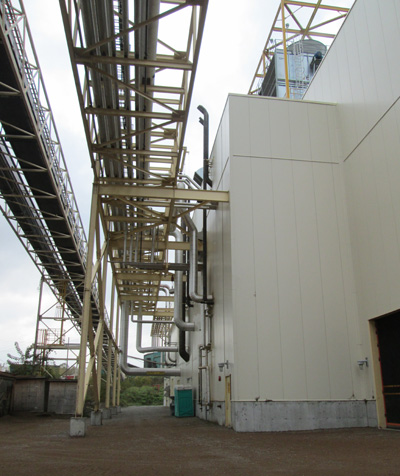Powering the Future: Cogeneration's rising popularity
 According to the International Energy Agency, power generation from non-hydro renewable sources including solar, wind, and bioenergy, will exceed gas and nuclear by 2016, and renewable power is expected to increase by 40% in the next five years.
According to the International Energy Agency, power generation from non-hydro renewable sources including solar, wind, and bioenergy, will exceed gas and nuclear by 2016, and renewable power is expected to increase by 40% in the next five years.
In an attempt to meet that figure, ongoing efforts and alternative applications and technologies for cleaner, more environmentally friendly forms of energy are being brought to the forefront. Solar energy, for example, continues to show positive signs of growth in the United States, with 832 megawatts (MW) of solar power installed in the second quarter of 2013—which marks a growth of 15% on the first quarter of the year. It’s predicted the cumulative solar capacity for the US will surpass 10 GW before the year is out (SEIA | www.seia.org). In terms of wind power, there were nearly 1,300 MW of project under construction at the end of the second quarter of this year, with over 900 MW of new wind capacity starting construction in the second quarter alone (AWEA | www.awea.org).
Although wind and solar power are well known, perhaps more common sources of renewable energy, they certainly aren’t alone. It’s estimated that around eight percent of world electric generation capacity comes from cogeneration power systems. At the end of 2011, there were nearly 70 gigawatts (GW) of combined heat and power (CHP) generating capacity spread across the United States. In other countries such as Finland (almost 40%) and Denmark (over 50%), however, cogeneration provides a substantial portion of the national power production.
Combined heat and power (CHP)—also called cogeneration—is a much more efficient approach to generating electric power and thermal energy from a single fuel source, which is then used for heating or cooling.
“Combined heat and power is the simultaneous production of electricity and heat from a single fuel source, such as: natural gas, biomass, biogas, coal, waste heat, or oil,” reports the US Environmental Protection Agency (EPA | www.epa.gov). Cogeneration was likely first introduced by Thomas Edison in 1882 at his Pearl Street Station, which combined heat and power, producing electricity and thermal energy. However, it’s only been in the last decade that this application has grown substantially in popularity, particularly as environmental concerns have intensified.
According to the US Energy Information Administration (EIA | www.eia.gov), the levels of several important greenhouse gases have increased by about 40% since large-scale industrialization began. And, during the past 20 years, about three-quarters of human-caused emissions have been the result of burning fossil fuels alone.
In terms of negating some of these destructive statistics and environmental impacts, cogeneration exemplifies a demonstrated, cost-effective and energy-efficient solution for delivering electricity and heat.
Waste not, want not
In traditional productions of electricity, some of the energy generated is lost and discarded as waste heat. In CHP or cogeneration by contrast, this thermal energy is put to use. All thermal power plants emit heat during electricity generation, which is usually released into the environment by cooling towers, flue gas, or by other means. Cogeneration, however, captures some or all of this excess by-product and puts it to use in terms of heat.
Cogeneration is more of a principle or application, rather than a single technology, with the main advantage of CHP plants offering optimal efficiency. Conventional power generation discards up to 65% of energy potential as waste heat. In comparison, cogeneration plants have a conversion efficiency of 75% to 90%. These plants are particularly useful in colder climates where the heat that’s saved can be used for warming buildings and heating industrial processes.
A further benefit lies in the proximity of most cogeneration facilities, at least compared to the 5% to 10% loss in transmission of electricity from more remote traditional power stations. The majority of today’s large industrial and commercial CHP applications are in the pulp and paper, chemical, refining, food processing, ethanol, and manufacturing sectors, which require vast amounts of electricity and heat, and typically run on natural gas. Granted, there’s a long way to go yet in terms of fully switching to renewable sources of energy, but natural gas is currently considered the cleanest form of fossil fuel available. And, cogeneration systems help reduce the impact of emissions and waste in that they use less fuel to produce the same amount of energy.
Burning biomass
Cogeneration is an integrated energy system that can be altered depending upon the needs of the energy user. Gas-fired cogeneration plants are common, but biomass-fueled plants have the added benefit of using a renewable, practically inexhaustible fuel source. In a pulp mill, for instance, wood waste that would typically end up in landfills can be recycled and used as fuel for onsite cogeneration plants, providing power for the pulp mill and for steam for operations. Plus, any additional power can be exported.
As a case in point, Fortress Paper has made a significant investment in CHP at their Fortress Specialty Cellulose Mill in Québec, Canada. They’ve constructed and recently upgraded an onsite cogeneration facility to produce up to 25 MW of clean energy, which successfully completed the mandatory 100-hour grid test. Their cogeneration facility will not only provide the benefit of reduced production costs at the mill itself, but it will also create a valuable source of environmentally friendly power production for the region. Fortress has also entered into an energy supply agreement with Hydro Québec to provide green power to the grid over a 15-year term.
Investing in tomorrow
In addition to renewable energy sources, such as wind and solar power, cogeneration systems play a crucial role in meeting North American energy needs and reducing the environmental impact of power generation that’s found with coal. It’s been reported that it takes 876 kilowatt-hours (kWh) to power a single light bulb continuously for a year—that’s 714 pounds of coal or 143 pounds of natural gas.
Quite simply, CHP or cogeneration systems require less fuel than conventional sources as heat and fuel are utilized to produce energy. Moreover, friendlier sources of biomass waste can also be used as a fuel to further lessen the impact on the environment. Because less fuel is burned to produce energy, CHP reduces greenhouse gas emissions. CHP’s high efficiency and reliability also result in overall savings for the operations. In the future, newer technologies such as fuel cells, with their small-scale applications, also play an important role in cogeneration’s future.
As more organizations invest in cogeneration, a noticeable reduction in peak electrical demand will be likely. This benefits utility providers by decreasing infrastructure costs and alleviating the upward pressure on electricity costs. As climate change caused by greenhouse gases becomes a growing global issue, the significance of CHP as a real way to reduce emissions is more obvious than ever before.
Chadwick Wasilenkoff is an established entrepreneur with extensive capital markets experience specializing in the resource industry. He currently serves as a director with various companies.
Fortress Paper
www.fortresspaper.com
Vorticom, Inc.
www.vorticom.com
Author: Chadwick Wasilenkoff
Volume: November/December 2013











